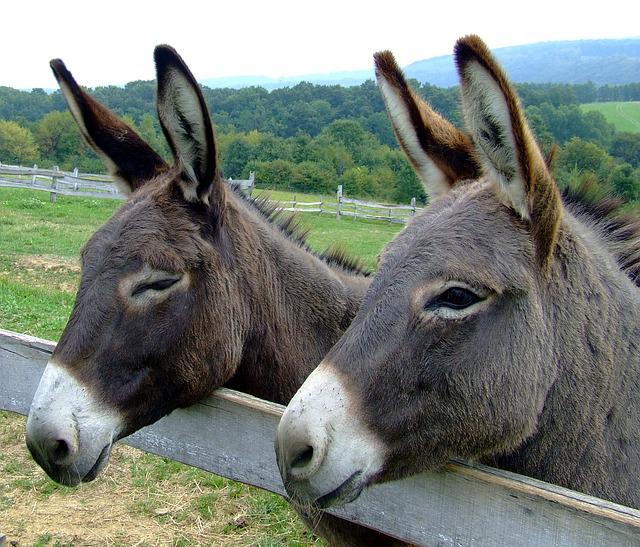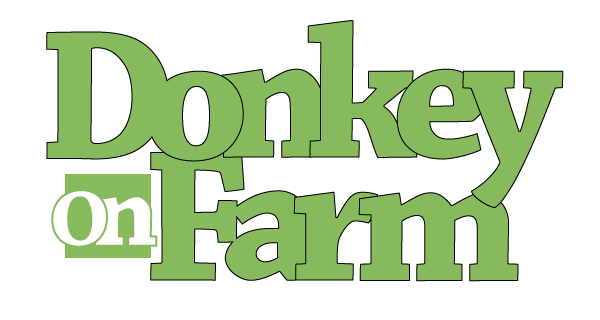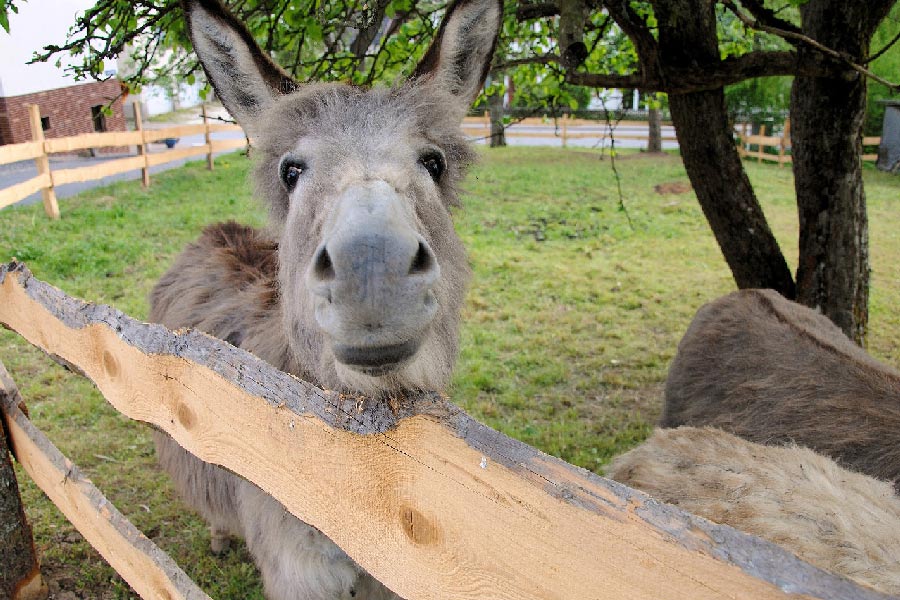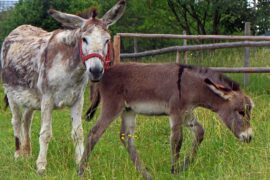Donkeys need ample space to graze. The number of donkeys you can have per acre land depends majorly on their size. Usually, a medium-sized donkey needs about 0.5 acres of land. That means you can have 2 medium-sized donkeys per acre.
We should also keep in mind that donkeys like to be in groups or in pairs. So there should be adequate land with easy access to water, fresh grass, and hay.
Allocate more land based on the size of the donkey
Logically, we need to allocate land based on the size of the donkey. A medium-sized donkey would need only 0.5 acres of land as we discussed above. But a mammoth donkey would need at least 1 acre of land for grazing.
When it comes to miniature donkeys, the area of your regular backyard should be sufficient for them.
It’s not just one donkey
This is an important aspect if you are just getting started with donkeys. You can’t just have one donkey. Donkeys do well in pairs or groups. A single donkey will always have a hard life and could feel lonely. So we would strongly advise getting at least two donkeys to start with. And importantly, when it is two donkeys, you should have enough land to accommodate them. That is at least 1 acre of land if you are getting 2 medium-sized donkeys. Or consider more if you are planning to get mammoth donkeys.
Have multiple paddocks and rotate them (divide your pasture)
Now that you know how much land to allocate to a donkey. It is also essential to have multiple paddocks and rotate them. This means dividing your pasture into 2 or 3 paddocks. The donkeys will have access to only one paddock for a fixed period of time (normally around 12 weeks) and the other paddocks will remain closed during this period. After the fixed time period, one of the other paddocks will be opened for the donkeys and the other two will remain closed.
This practice of rotating paddocks is a great way to grow fresh grass on the resting paddocks. This will also help in breaking the lifecycle of certain parasites and thereby reducing the infection with worms. Normally, the resting period for a paddock should be at least 12 weeks. This would provide ample time for the fresh grass to grow and also to break the parasite lifecycle.
To divide your pasture effectively, it is advised to have proper fencing between the paddocks. The fencing will also keep the donkeys safe. You can choose either post and rail fencing or even electric fencing based on your budget and requirement. Irrespective of the type of fencing, it should not cause any injuries to the donkeys. Any sharp objects or edges associated with the fencing should be removed while setting it up.

Provide shelter from sun, snow, and rain
Donkeys need a safe shelter from sun, snow, rain, and winds. Ideally, the shelter should be placed in such a way that it is easily accessible from all the paddocks. This would help the donkeys to move to the shelter from any of the paddocks easily. Also, this would make the process of rotating paddocks easier by just blocking the entry to a paddock from the shelter.
Easy access to water, grass, and hay
The land allocated to the donkeys should have easy access to drinkable water, fresh grass, and hay. Ideally, the drinking water and free hay can be kept under the shelter where donkeys can munch on them comfortably. Keep one paddock open for the donkeys to get fresh grass.
Keeping the paddocks clean
All the paddocks should be kept clean to prevent the growth of parasites and break their lifecycle. Donkey dung should be removed from the paddocks at least twice a week. This needs to be done for all the paddocks in use.
Also, make sure there are no weeds or unknown plants growing in the pasture along with fresh grass. Certain types of weed could be poisonous to the donkeys and can cause potential health hazards.
Overgrazing the pasture
Make sure you have enough land to divide the pasture into multiple paddocks depending on the number of donkeys you have. The donkeys shouldn’t be allowed to overgraze on any of the paddocks. This is why it is advised to strictly follow paddock rotation.
Overgrazing can lead to damaged land and can also cause health problems for the donkeys. Depletion of fresh grass caused by overgrazing may push the donkeys to munch on other plants and vegetation that could cause bigger health problems.

What to know when donkeys are kept with other farm animals
Donkeys can make good guard animals. They can protect other farm animals from predators like coyotes. But at the same time, they are very territorial. Male donkeys are usually more aggressive and are hard to train. Female donkeys are comparatively easy to train and tend to adjust better with other farm animals.
Donkeys, when they are brought up and fed with other farm animals, tend to become better guard animals. If you are planning to have donkeys along with other farm animals, make sure you have enough land for all of them.
Conclusion
Donkeys can be great companions to humans. But at the same time, they need enough care and attention. One of the most important aspects is to have enough land to accommodate your donkeys. Make sure you have a good pasture and it is divided into multiple paddocks for rotation. Also, build a good shelter to provide them protection from sun, rain, and snow. Caring for donkeys need patience, but when treated well, they tend to form a great bond with their owners.



![Should Donkeys Be Stabled at Night? [With Alternatives to a Stable] Should-donkeys-be-stabled-at-night](https://donkeyonfarm.com/wp-content/uploads/2023/04/Should-donkeys-be-stabled-at-night-270x180.jpg)
![How Much Can Donkeys Carry? [Avoid Burdening] How-much-can-donkeys-carry](https://donkeyonfarm.com/wp-content/uploads/2022/04/How-much-can-donkeys-carry-270x180.jpg)
![How Much Does it Cost to Maintain a Donkey? [Is it Expensive?] How-Much-Does-it-Cost-to-Maintain-a-Donkey](https://donkeyonfarm.com/wp-content/uploads/2022/09/How-Much-Does-it-Cost-to-Maintain-a-Donkey-270x180.jpg)
